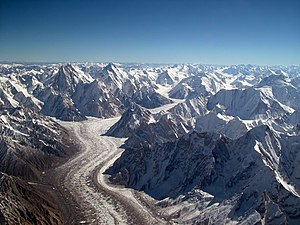Glacier: Large persistent body of ice
A glacier is a large body of ice and snow.
It forms because the snow in an area does not all melt in summer. Each winter, more snow is added. The weight of all the snow creates pressure. This pressure turns the lower parts of the snow into ice. After this happens for many years, the glacier will start growing large. It becomes so heavy that gravity causes the ice to move. It flows downwards like water but very slowly. A glacier only moves about 50 metres (160 ft) per year. New snowfalls replace the parts that flow away.

Glaciers are the largest sources of fresh water on Earth. The largest bodies of salt water are the oceans.
Creation

Glaciers will only form in places that are cold enough and get enough snow over time. This can take a long time. It often takes tens or hundreds of years for a glacier to form. There are two kinds of glaciers: continental glaciers and alpine glaciers. Alpine glaciers are also called mountain glaciers.
- Continental glaciers are glaciers that spread out over a large area of land. They were created mostly during the Ice Ages a long time ago. There are still some continental glaciers in Greenland and Antarctica. They often flow downwards into the sea and break up. The broken parts that float in the sea are called icebergs.
- Alpine glaciers form in mountain areas. They are smaller than continental glaciers. Alpine glaciers usually flow until they reach a point where the temperature is warm enough that the ice melts completely during the summer.
Effects
Glaciers are very important. They have a large effect on the environment. They do this because they are very large and heavy. When they move, they erode mountains and land. Also, since they froze long ago, snow crystals and air bubbles inside are kept in good condition. These can provide a large amount of information for scientists. Recently glaciers have been melting more than they did in the past. Many scientists think this is happening because global warming is changing the climate[source?].
Appearance
Glaciers are blue in color. This is because water is very good at absorbing light. Only the strongest light, with the most energy, is able to escape. Blue is the color of light that has the most energy. Because of this, blue is the only color of light that can escape without being absorbed. The thicker the glacier is, the more blue it appears.
References
Uncited references
- Walley, Robert (1992). Introduction to physical geography. Wm. C. Brown.
Other websites


- Swisseduc - Glaciers online Website on Glaciers in English and German
- Time lapse movies of Grosser Aletschgletscher
- Illustrated glossary on Glaciers online, in English and German
- Glacier information for schools
- National Snow and Ice Data Center - Glaciers Archived 2007-01-16 at the Wayback Machine
- USGS Glacier Studies Project Archived 2007-01-13 at the Wayback Machine
- Glaciers and Glacial Hazards - USGS
- 2003-08-15 Scientists Rewrite Laws Of Glacial Erosion
- Fjords National Park, Alaska
- NOVA scienceNOW - A 7-minute video of the NOVA broadcast of July 26, 2005. Hosted by Robert Krulwich, the video is about the world's fastest glacier and why it is moving too fast.
This article uses material from the Wikipedia Simple English article Glacier, which is released under the Creative Commons Attribution-ShareAlike 3.0 license ("CC BY-SA 3.0"); additional terms may apply (view authors). Content is available under CC BY-SA 4.0 unless otherwise noted. Images, videos and audio are available under their respective licenses.
®Wikipedia is a registered trademark of the Wiki Foundation, Inc. Wiki Simple English (DUHOCTRUNGQUOC.VN) is an independent company and has no affiliation with Wiki Foundation.
